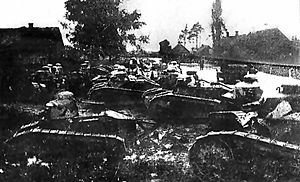- Battle of Daugavpils
-
Battle of Daugavpils Part of Polish-Soviet War and Latvian War of Independence 
FT-17 tanks of the Polish 2nd Tank Regiment preparing for the battleDate September 28, 1919 to January 15, 1920 Location Daugavpils and vicinity, Latvia Result Decisive Polish-Latvian victory Belligerents  Poland,
Poland,
 Republic of Latvia
Republic of Latvia Bolshevist Russia,
Bolshevist Russia,
 Latvian SSR
Latvian SSRCommanders and leaders  Edward Rydz-Śmigły
Edward Rydz-ŚmigłyUnknown Strength 2 infantry divisions,
a tank regimentUnknown Casualties and losses Unknown Unknown - Target Vistula
- Bereza Kartuska
- Pińsk
- Lida
- Vilna
- Minsk
- 1st Berezina
- Daugavpils
- Latyczów
- Mozyr
- Korosteń
- Koziatyn
- 2nd Berezina
- Kiev
- Wołodarka
- Głębokie
- Mironówka
- Olszanica
- Żywotów
- Miedwiedówka
- Dziunków
- Wasylkowce
- Bystrzyk
- 1st Brześć
- 1st Grodno
- 1st Niemen
- Boryspol
- Auta
- Dubno
- Kobryn
- Łomża
- Brody
- Dęblin
- Nasielsk
- Serock
- Radzymin
- Ossów
- Warsaw
- Płock
- Wkra
- Cyców
- Ciechanów
- Lwów
- Zadwórze
- Mława
- Białystok
- Komarów
- Dytiatyn
- 2nd Niemen
- 2nd Grodno
- 2nd Brześć
- Mołodeczno
- 2nd Minsk
Battle of Daugavpils (also known as the Battle of Dyneburg) was the final battle of the joint Polish and Latvian Operation Winter against the Red Army. It took place in late December 1919 in the area around the city of Daugavpils. The fighting in the area started on September 28, and ended in January 1920.
From the Polish perspective it was a part of the Polish-Bolshevik War, while in Latvia it is referred to as a part of Latvian War of Independence.
The Polish commander of the 1st Legions Infantry Division general (later Marshal of Poland) Edward Rydz-Śmigły in late autumn of 1919, proposed that a joint Polish-Latvian operation against the Bolshevik forces be commenced. The front lines in the area were relatively peaceful and the city of Daugavpils could be captured relatively easily, especially since the Red Army was concentrating its forces further southwards. However, lack of support from Polish headquarters, as well as a personal conflict with general Stanisław Szeptycki resulted in Rydz-Śmigły's plan being refused.
However, the situation changed in December 1919, after an military alliance had been signed between the governments of Poland and Latvia. General Rydz-Śmigły was given the command over a small Operational Group composed of his 1st Legions Division, as well as the 3rd Legions Infantry Division and several minor Latvian auxiliary forces. The tanks of the 2nd company, commanded by the French Cpt. J. Dufour.
The battle for the city and its surroundings took place under harsh weather conditions, the area was covered with more than one meter of snow and the temperature dropped below −30 C°. The Polish-Latvian forces reached the area of the Daugavpils fortress almost unopposed; Poles attacking from the south and Latvians from the north. Polish forces moved into the city and took the fortress without much opposition from the Russians.
Soon afterward the Poles relinquished control of the city to the Latvians. Thanks to that, the interwar relations between Poland and Latvia were good, although Latvia refused to join Poland in its continued struggle against Soviet Russia. The problems that precluded the Polish and Latvian governments from expanding their relationship were the opposition from Lithuania (which was hostile towards Poland after the Polish-Lithuanian War) and a dispute about six Latvian rural municipalities and the city of Grīva with a big percentage of Polish inhabitants (south to the Daugava River).[1] Several forms of alliance were proposed by Poland, such as Latvia joining the Międzymorze federation of Poland. It chose to join the Baltic Entente instead.
See also
References
- ^ (Polish) Łotewski sojusznik (Latvian ally) by Daniel Kochan, last accessed on 25 October 2006
Categories:- 1919 in Poland
- 1920 in Poland
- Battles involving Latvia
- Battles of the Polish–Soviet War
- 1919 in Latvia
- 1920 in Latvia
- History of Daugavpils
Wikimedia Foundation. 2010.

